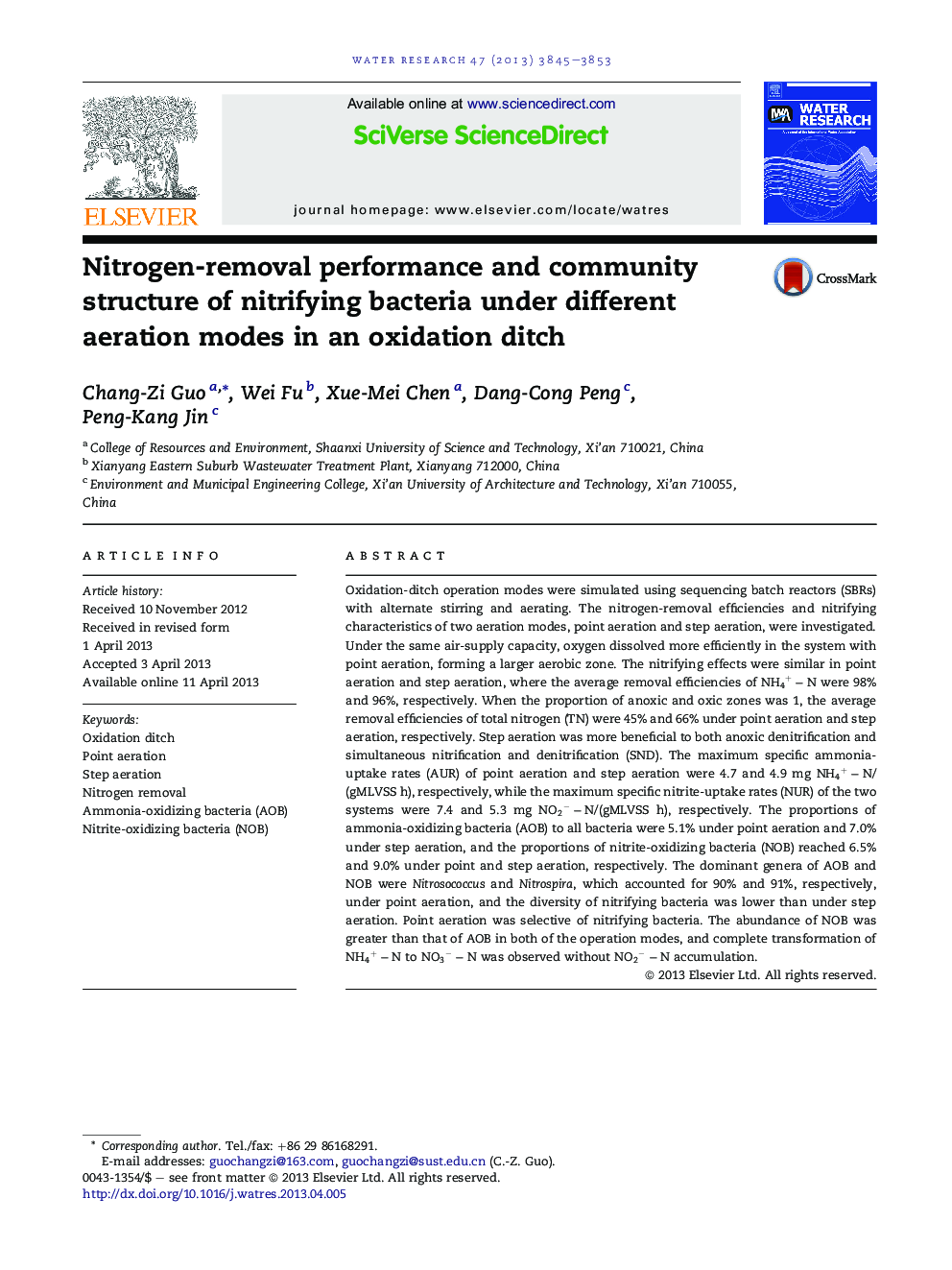| کد مقاله | کد نشریه | سال انتشار | مقاله انگلیسی | نسخه تمام متن |
|---|---|---|---|---|
| 4482196 | 1316850 | 2013 | 9 صفحه PDF | دانلود رایگان |

• Oxidation ditch operation modes were simulated by sequencing batch reactors (SBRs).
• Oxygen was dissolved more efficiently in point aeration.
• Step aeration was more beneficial to both anoxic denitrification and SND.
• Point aeration was selective of AOB and NOB.
Oxidation-ditch operation modes were simulated using sequencing batch reactors (SBRs) with alternate stirring and aerating. The nitrogen-removal efficiencies and nitrifying characteristics of two aeration modes, point aeration and step aeration, were investigated. Under the same air-supply capacity, oxygen dissolved more efficiently in the system with point aeration, forming a larger aerobic zone. The nitrifying effects were similar in point aeration and step aeration, where the average removal efficiencies of NH4+-NNH4+-N were 98% and 96%, respectively. When the proportion of anoxic and oxic zones was 1, the average removal efficiencies of total nitrogen (TN) were 45% and 66% under point aeration and step aeration, respectively. Step aeration was more beneficial to both anoxic denitrification and simultaneous nitrification and denitrification (SND). The maximum specific ammonia-uptake rates (AUR) of point aeration and step aeration were 4.7 and 4.9 mg NH4+-NNH4+-N/(gMLVSS h), respectively, while the maximum specific nitrite-uptake rates (NUR) of the two systems were 7.4 and 5.3 mg −NO2-NNO2−-N/(gMLVSS h), respectively. The proportions of ammonia-oxidizing bacteria (AOB) to all bacteria were 5.1% under point aeration and 7.0% under step aeration, and the proportions of nitrite-oxidizing bacteria (NOB) reached 6.5% and 9.0% under point and step aeration, respectively. The dominant genera of AOB and NOB were Nitrosococcus and Nitrospira , which accounted for 90% and 91%, respectively, under point aeration, and the diversity of nitrifying bacteria was lower than under step aeration. Point aeration was selective of nitrifying bacteria. The abundance of NOB was greater than that of AOB in both of the operation modes, and complete transformation of NH4+-NNH4+-N to −NO3-NNO3−-N was observed without −NO2-NNO2−-N accumulation.
Oxidation-ditch operation modes were simulated using sequencing batch reactors (SBRs) with alternate stirring and aerating. The nitrogen-removal efficiencies and nitrifying characteristics of two aeration modes, point aeration and step aeration, were investigated. Under the same air-supply capacity, oxygen dissolved more efficiently in the system with point aeration, forming a larger aerobic zone. The nitrifying effects were similar in point aeration and step aeration, where the average removal efficiencies of NH4+-NNH4+-N were 98% and 96%, respectively. When the proportion of anoxic and oxic zones was 1, the average removal efficiencies of total nitrogen (TN) were 45% and 66% under point aeration and step aeration, respectively. Point aeration, exhibiting a lower abundance of AOB and NOB, was disadvantageous for both anoxic denitrification and SND. Step aeration, with a higher abundance of AOB and NOB, had better TN-removal efficiency and higher diversity of nitrifying bacteria in comparison to point aeration, which was selective of nitrifying bacteria.Figure optionsDownload high-quality image (175 K)Download as PowerPoint slide
Journal: Water Research - Volume 47, Issue 11, 1 July 2013, Pages 3845–3853